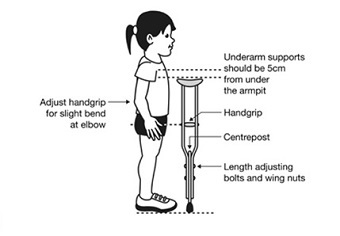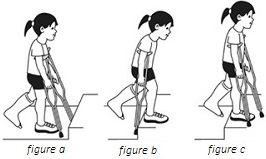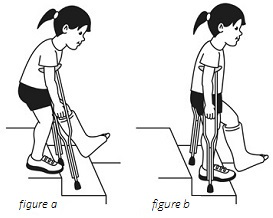Utilizing crutches can expedite your recovery from leg, foot, or ankle injuries by alleviating pressure on the injured limb. It's crucial to start slowly and grasp the proper usage of crutches, as there's a risk of falling or losing balance.
Adjusting the crutches to fit you correctly is essential. Here's how to do it:
- Stand up straight and measure from your armpit to the floor. Subtract 5 cm from this measurement to determine the appropriate crutch length. If standing isn't feasible, measurements can be taken while lying down.
- Adjust the handgrip height so that when you stand in a relaxed position, your elbows are slightly bent.
- Ensure the crutches are safe for use by tightening the wing nuts and inspecting the rubber stoppers at the bottom (crutch tips) to ensure they're securely attached and in good condition.

Once the crutches are properly adjusted, wear non-slip shoes and adhere to the weight-bearing instructions provided by your healthcare provider.
Here's how you should use the crutches:
- Stand upright with balanced posture, feet slightly apart, and crutches positioned about 10 to 15 cm to the side and slightly in front of your feet.
- Hold the handgrips firmly against your body with your upper arms pressed against your sides (elbows slightly bent).
- Move both crutches forward simultaneously, ensuring they're not placed too far ahead or too far apart.
- Transfer weight onto your hands and push down on the crutch handles while moving your good leg forward.
If weight-bearing on the injured leg isn't permitted, it should remain off the ground. If partial weight-bearing is allowed, the injured leg can touch the ground lightly while your hands support most of the weight.
If you experience difficulty using crutches, a physiotherapist can provide assistance with sizing adjustments and proper usage techniques.
Sitting down or standing up with crutches involves holding the crutches in one hand, placing the injured leg forward, and using the other hand to grip a surface for support while either lowering onto a seat or pushing up to stand.
Negotiating stairs with crutches requires caution.
If weight-bearing on the injured leg isn't allowed, alternative methods such as sitting and moving up or down on the bottom can be employed.
Going up: "Good foot, sore foot, crutches" | |
You should:
| |
Going down: "Crutches, sore foot, good foot" | |
You should:
|
Key reminders:
- Slow and steady progression in crutch usage is recommended.
- Weight should be borne by your hands, not your armpits.
- Proper crutch positioning is essential for stability and effectiveness.
- Extra care is needed when using stairs.
FAQs
How long do I use crutches?
The duration of crutch use varies depending on the severity of the injury and the speed of recovery. Consultation with a physiotherapist, GP, or orthopedic surgeon is advised for personalized guidance.
Why am I not allowed to place weight on my arm pits?
Placing excessive weight on the armpit by leaning on the crutch can compress important nerves, leading to potential long-term issues. The top part of the crutches primarily serves for stability; weight should be primarily supported by the handles.

